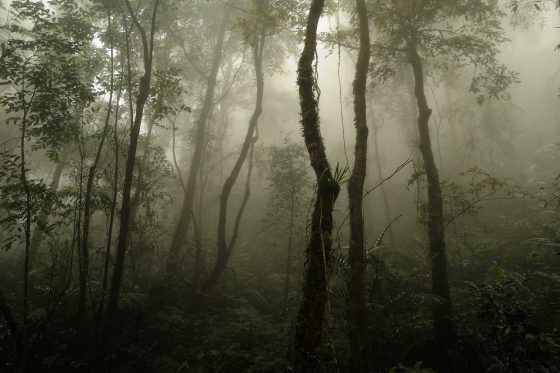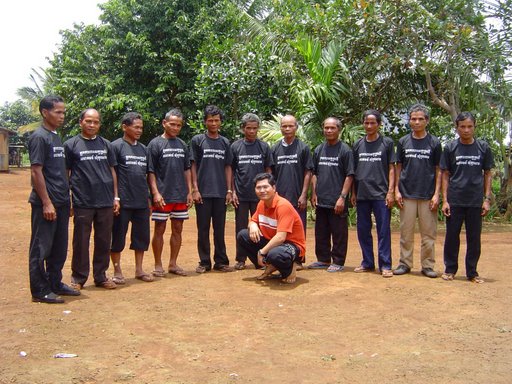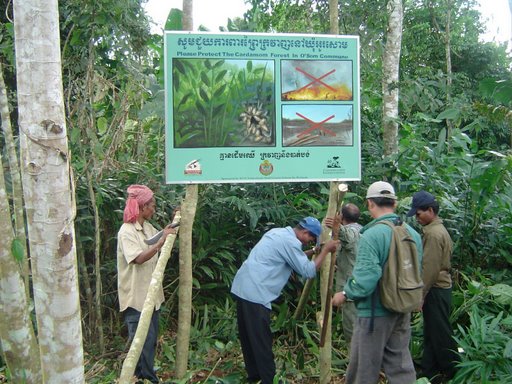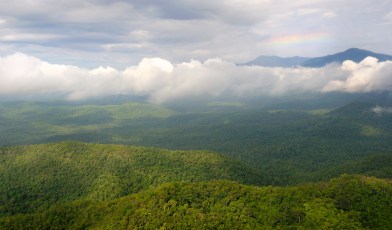Why this species?
Beng trees are protected by law in Cambodia, but illegal logging has escalated since the 1990s. Furniture made from its flame-coloured timber has become a status symbol and sells for high prices to the country’s rapidly growing middle-class for use in hotels, boardrooms and mansions. The demand for beng timber far exceeds the supply, and the species is vanishing from even the most remote protected areas.
The trade is orchestrated by powerful dealers who recruit local villagers to find, cut and transport the trees for a fraction of the timber’s worth. Stronger protection measures were needed to protect the remaining beng trees in protected forest areas.
In 2008, GTC worked with FFI’s Cambodia programme to support measures to prevent illegal logging in Phnom Samkos Wildlife Sanctuary, a 332,566-hectare protected area in the Cardamom Mountains, which supports at least 17 globally threatened trees, including a large but dwindling population of beng.

Misty montane forest Cardamom Mountains. Credit: Jeremy Holden/FFI
What did we do about it?
This project was implemented in partnership with the government’s Department of Nature Conservation and Protection (DNCP), and the Cambodian Centre for the Study and Development of Eco-Agriculture (CEDAC), a national NGO). The rangers at Phnom Samkos Wildlife Sanctuary were trained and better equipped to combat threats to beng and other endangered trees. To decrease the likelihood that local communities would engage with illegal logging operators, the project also worked to support and strengthen existing livelihoods (e.g. improving rice yields).
Key achievements and future directions
Training rangers on species monitoring techniques such as tree identification enabled the locations of key tree populations to be recorded and incorporated into the monitoring information system (MIST) used to plan ranger patrols. Beng remains one of the indicator species that is documented during patrols, so it is evident that working with protected area staff to increase capacity and develop a focus on target tree species can leave a lasting legacy.
The increase in enforcement activity, with better equipped rangers patrolling on a continual basis, resulted in an increase in the apprehension of illegal loggers during the project period: between 2007 and 2008 the number of prosecutions and chainsaws confiscated increased from 6 to 20 and 37 to 52 respectively. The amount of luxury timber (all globally threatened species) confiscated decreased from 250 to 177 cubic meters, and the number of illegal camps decreased from 58 to 33.

Community wardens, trained by FFI, supplement the work of the government rangers to protect their forests and wildlife. Credit: FFI
Over 700 farmers (71% being female) were more knowledgeable on sustainable agriculture following project training sessions. Some local farmers continue to use a system of rice intensification (a system that can double yield on existing farmland, thereby reducing the need to clear more forest).
Local communities understand the rarity of beng and put into place local regulations on cutting within community protected areas- a positive lasting impact of the project. However migrants who temporarily move to the area to find manual labour jobs continue targeting beng trees for trade.
Important learning from this work is that tackling illegal logging of a high-value timber species is very complex; while it may be possible to have an immediate significant short-term impact, isolated small scale grants need to be backed up by long-term and well-funded enforcement programmes to generate a lasting change. This is especially the case where powerful individuals or syndicates are involved in the unsustainable use of high value species. There was a notable shift in logging pressure from beng to rosewood after the project, which mirrors learning from other projects; once the risks increase or rewards decrease for harvesting a particular species; loggers typically move on to other high value species. Enforcement needs to address the protection of multiple high value species across a site to be effective in the long-term.

Signage to protect a community forest. Credit: FFI
Contact details
For more information on this project, please contact [email protected]
